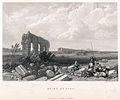مستخدم:Futoon Badr/sandbox2
Tire ruins
The ruins of Tire are a collection of archaeological sites in the city of |Tyre, in southern LebanonSouthern Lebanon. Since the forties of the twentieth century, the Lebanese government has been carrying out extensive excavation campaigns in the area of the Phoenician city in search of the city's antiquities and history. In 1979, the United NationsUnited Nations UNESCO organization included the city of Tire on the list of World Heritage Sites.[1]
Archaeological sectors
the excavations in the city focused on three sectors of the ancient and intermediate city.
First Sector
The first sector occupies part of the site on which it was based in the maritime city, which was built on an island before Alexander the Great filled the sea and connected it to the opposite land. The excavations showed that the ancient sea city consisted of residential quarters, public baths, sports complexes, and streets with arcades and paved with mosaic floors. All of these facilities date back to the Roman and Byzantine eras, not to mention some remnants of the docks of the southern Phoenician port, or the Egyptian port, which are still scattered near the beach.
Second Sector
The second sector is located to the west of the first sector and is centered on the remains of the Crusader Tire Cathedral, which used red granite columns and stones that were extracted at the time from Roman facilities. There is a network of roads and dwellings dating back to Roman and Byzantine times around the church, and at lower levels.
Third Sector
The center of the third sector is to the east of the two previous sectors, and it is called the Al-Buss site, and it consists of a main street heading from east to west and connecting the city with its eastern suburb. This street was built in the Roman era, and was restored in the Byzantine era, in the middle of the isthmus established by Alexander the Great. Arcades surround both sides of this street, and it is crossed by a great triumphal arch with three entrances. On its southern side, a canal hangs over aqueducts that were intended to draw the waters of the Ras al-Ayn spring into the city. On both sides of the street, large tombs intertwine with funerary structures, marble, limestone and basalt coffins of various shapes, decorations and sculptures. The period of use of this cemetery lasted from the second century to the sixth century AD. To the south of the cemeteries, there is a horse chariot race track, some parts of which have been restored. The field is 480 meters long and could [2].accommodate about 20,000 spectators
Old Markets
In the area of the old markets, there is a khan and an old and beautiful house from the Ottoman era. And the mosque of the Shiite community with two domes and magnificent architecture, and the Great Mosque of the Sunni community. Near the market, there is the old fishing port that replaced the northern Phoenician port, which was known because of its location as the Sidonian port. The road adjacent to the pavement leads to the Christian Quarter, which still retains its alleys and traditional-style buildings. It may surprise you, and there is a watchtower from the Crusader era in one of the orchards, and another tower near the lighthouse.[3]
The Algerian Historical Tower
A new archaeological tower was discovered in the vicinity of Jumblatt Square in the city of Tyre. It was named “Al-Jazairien Tower”, a tower referred to in old maps of the city of Tire dating back to the eighteenth and nineteenth centuries. The 12th-13th centuries AD. Excavators within the site found archaeological layers dating back to more ancient times, including a water channel and rooms of different types
- Umm Al-HamednTemple in Tyre
- Roman Triumphal Arch
- The Christian Quarter in Tyre
- Tyre Columns
- The sea lane leading to Tire Marine
- Tyre Columns
- From the ruins of the city of Tyre
- Triumphal arch with three openings
- A map of Clerckenwell from 1805 AD
- Alexander’s siege of Tyre
- Shrine of King Ahiram ,King of Tyre















